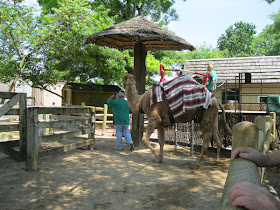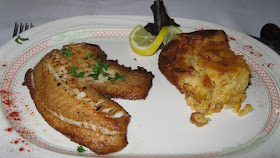So, 33 months after we moved into east
Tennessee, we had yet to visit the Knoxville Zoo. This is unusual for us as we really like to
view animals and watch them interact with their surroundings. It isn’t like the zoo doesn’t advertize…
We’ve seen plenty of ads as well as stories on TV about the zoo and its various
activities. In any case, we finally took
the plunge and drove over to the east side of Knoxville for one more area
experience…
The Knoxville Zoo was founded in 1948
with a single caged alligator. Visitors
were asked for penny donations so the alligator could be cared for. The zoo now encompasses 53 acres, contains over
800 animals and it’s visited by more than 400,000 people each year. On the rather warm late spring day that we
were at the zoo, it felt like most of the 400,000 were there at the same
time. It was a very busy day!
These are African Wild Dogs. They range in size from 40 to 79 pounds,
mostly dependent on their environment and available food. While there used to be approximately 500,000
African Wild Dogs scattered across 39 African nations, current estimates are
that there are between 3,000 and 5,500 of these canids surviving in 14
countries.
The African Wild Dog is a very successful
hunter. They hunt in packs…running their
chosen prey down in a long chase…with an 80% success rate! Their bite force is the strongest of any
mammalian carnivore…they can crunch bone. These dogs can also run at speeds reaching 40 mph. for 3 miles or more.
Laurie took a photo of this young
Chimpanzee sitting alone on the rocks in the Chimpanzee exhibit area. Chimps are members of the Hominidade Family,
as are gorillas, orangutans and humans.
Males can be 5’ 6” tall when standing and they can weigh up to 150
lbs.
In the wild, Chimpanzees live in groups
or communities of between 15 and 150.
It’s estimated that between 170,000 and 300,000 remaining in the
wild. They are listed as
endangered. In many areas of Africa,
they are hunted as ‘bushmeat’ or medicinal purposes for human consumption. They are also very vulnerable to many
diseases that affect humans.
Laurie loves horses…and of course Zebra’s
evolved from Old World Horses. These 2
Plains Zebras decided to lay down in the shade near the fence and pose for this
photo. Plains Zebras range over most of
Africa south of the Sahara. They are
protected over much of their range due to their value as tourist attractions.
A big male zebra can reach 4’ 8” at the
shoulder and they can weigh up to 850 lbs.
Zebras will migrate over 700 miles in search of food and water. Up to 50% of all Zebra foals die in their
first year due to disease, starvation and predation by lions, hyenas and other
meat eating animals.
This African Elephant is working at
removing hay from the barrel using his trunk.
A big African Elephant can reach 13’ in height at the shoulders and they
can weigh over 6.5 tons! (13,300 lbs) They are indeed the world’s largest
living terrestrial land animal.
The Knoxville Zoo really hit the big time
as a zoological park back in 1978 when it produced the 1st African
Elephant born in captivity in the Western Hemisphere! She was named “Little Diamond”. Of all of the exhibits at the Knoxville Zoo,
the elephant area seemed to be the most current and attractive…good for both
the animals and zoo visitors.
This is an Eastern Black Bear… Around
here, they are fairly common. A couple
of years ago, one was caught in a culvert trap about a block from our home.
(They used Twinkies and Crispy Cream Donuts to bait the trap) He’d been raiding
bird feeders. He was returned to the
Cherokee National Forest or the Smoky Mountain National Park.
There are twice as many Black Bears around
the globe as there are all other species of bears in the world and they are
listed as a ‘Least Endangered’ Species.
While Black Bears are not particularly aggressive, it’s a good idea not
to come between them and a berry patch or to get too close to a mother bear and
her cub. For short distances, Black Bears
can run up to 30 mph…can you?! The
record size for a male black bear was recorded in New Brunswick Canada back in
1972. He weighed in at about 1,100 lbs.
and he was 7’ 9” long! A large black
bear normally wouldn’t exceed 550 lbs. but all bears are very strong.
For the best wild Black Bear viewing in
North America, visit Orr Minnesota. There are 20 + bear feeding stations all
around an open viewing platform in a clearing in the woods. You arrive before the bears amble in from the
woods for their dinner and you leave when they’re done. It was amazing when we saw that many wild
bears…being served dinner by humans. For
more information, just go to http://www.americanbear.org/.
The Knoxville Zoo also has camel rides,
(in-season @ $5.00), and carousel rides for $2.00. The Zoo is a non-profit organization and it
frequently stages events to raise money.
There is the “Feast with the Beasts”; the Zoofari (an elegant dinner
with a silent auction); Boo at the Zoo (Halloween), and; Jungle Love (on
Valentine’s Day).
Note: It costs $22,400 each day to
operate the Knoxville Zoo.
This is a Red Panda. The Knoxville Zoo is well known for its
successful breeding of Red Pandas and indeed, the worldwide ‘studbook’ for Red
Pandas is maintained by Zoo personnel.
The Zoo has produced approximately 100 Red Pandas, only surpassed by the
Rotterdam Zoo in the Netherlands. Red
Pandas are listed as “Vulnerable” with only an estimated 10,000 mature animals
existing in the wild.
These cute little animals are about the
size of a housecat, rarely exceeding 14 lbs.
They are only distantly related to Giant Pandas…but rather are more
closely akin to Raccoons…although the Red Panda is considered a living fossil…the
only animal in its assigned family or genus.
These appealing animals mostly eat bamboo but they will eat meat given
the opportunity. They cannot tolerate
temperatures in excess of 77 degrees.
The Knoxville Zoo has several types of
tortoises and turtles on display. Those
in the photograph above are Aldabra Giant Tortoises. They are one of the largest living reptiles,
with adult females weighing in at roughly 150 lbs. and males tipping the scales
at between 300 and 600 lbs.
There are about 150,000 of these
Tortoises worldwide, with most of them living on the Aldabra Atoll in the
Indian Ocean. The Aldabra Atoll is the
second largest atoll in the world at 60 square miles of land surface…and most
of the tortoises live on this island.
The island is a UNESCO World Heritage Site. Its part of the Seychelles but Aldabra is isolated
and uninhabited.
I liked this wall of donors…I’m guessing
with the different animals shown representing the amount of the donation.
In the early 1970’s a local politician,
Guy Lincoln Smith III, offered a pet lion to the struggling zoo. The catch was that he insisted that the zoo
needed a major clean-up first. He forced
the issue and worked to get the job done.
He wrote a book about the experience, entitled “A House for Joshua – The
Building of the Knoxville Zoo”. Joshua
was of course, Smith’s pet lion. The
book is still available at http://www.amazon.com/House-Joshua-The-Building-Knoxville/dp/0870494600.
The zoo has a nice display of Southern
White or Square Lipped Rhinoceros. There
are only about 17,000 surviving in the wild, mostly in South Africa. Males are typically 13’ long and average
5,100 lbs., (about 2.5 tons). The largest known Southern White Rhino weighed in
at 9,900 lbs. (close to 5 tons!)
Other animals in the Knoxville Zoo
include River Otter, Andean Condors, Snakes, Alligators, Red Fox, Bald Eagle,
Marmoset, Baboons, Red Wolf, Reticulated Giraffe, Lions, a Tiger, Sandhill
Cranes, Waterbuck Gazelle, Wild Boars, Prairie Dogs, Penguin, Bobcats, snakes,
a Komodo Dragon and Meercats.
The Zoo is addressing some of the key
issues that we noted during our visit.
You may have noted the lack of big cat photos. The cages were set back so far that you
couldn’t really view the animals. The facilities
for the big cats and the baboons were really run down. The good news is that the Zoo is in the midst
of a $4 million renovation project. The
first items under construction are the Lion and Baboon enclosures. They will be followed by the Tiger enclosure
and then a new reptile facility.
While the Knoxville Zoo was interesting
and there were some nice exhibits, it didn’t measure up to some of the big city
zoos that Laurie and I have visited. The
new improvements will greatly enhance the visitor’s experience, providing an
upscale experience from a medium sized operation. Our biggest complaint was that, because of
the crush of visitors, we ended up walking a long way up hill from the overflow
parking lot. Given the hilly nature of the
Zoo, my old knees didn’t need the extra strain of climbing/walking as far as it
was to the actual zoo entrance.
The Knoxville Zoological Garden is
located at 3500 Knoxville Zoo Drive in Knoxville Tennessee. Phone: 865-637-5331. Admission is $19.95 for adults and $15.95 for
seniors as well as for children between the age of 2 and 12. Parking is another $5.00. Considering that a family of 4 would have to
pay $76.80 and $5.00 for parking, (plus food and drinks), we were very impressed
with the big crowds! For further
information, just go to www.knoxville-zoo.org.
Just click on any photo to enlarge it…
Thanks for joining us on our East
Tennessee Safari!
Take Care, Big Daddy Dave




















































